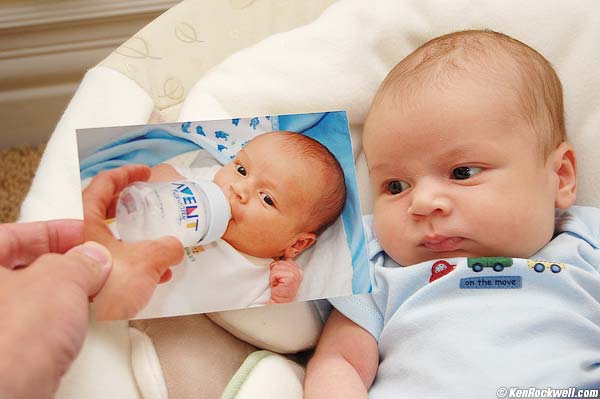Home Search Gallery How-To Books Links Workshops About Contact
Digital original vs. cheap auto scan from a cheap print. I
get my goodies at Ritz, Amazon and Adorama. INTRODUCTION Too many marketers of color management tools have done too good a job. Sadly, many impressionable photographers believe the ads and seminars and waste too much time and money getting crummier results than if they left everything alone. I shoot and print, never waste any time with profiles or spaces, and everything looks great. Color profiles and color spaces are for dweebs. You don't need them. I'm a dweeb, I invented the world's first dedicated digital color-space conversion chip back in 1990 with TRW, and even I don't bother color managing anything except my monitor. No photographer needs to do color management manually any more. Color management is already built into everything by designers who know what they're doing. Any attempts to outsmart them usually delivers crummier results than leaving everything alone. Mess with profiles and color spaces and you'll probably get bad results. Leave it all alone, and you'll get great results. Ditto for people still wasting their time with inkjet printers, which went obsolete back in 2004. I send all my prints out. It's faster, costs less, lasts forever and looks much, much better. The print scanned above cost me 59 cents over two years ago, and has been sitting on our counter, in partial daylight, ever since. How good are 17-cent prints in 2007? Let's ask my baby, Ryan Rockwell. Here he is next to a print of himself made the day before. Ryan Rockwell and Self. Here's the genuine article next to his photo, a 17-cent special from Price Club (Costco). No profiles, no nothing: just shoot. The saturation is a bit higher in the print because I deliberately have the saturation jacked up in my D40, with which I made the original shot and this shot. This is excellent. It's not supposed to match - cameras are creative devices, not copy machines. The fact that it's this close amazes me, and the only difference I see is that I crank the saturation in my cameras. THE EPIPHANY This morning I was noticing how a cheap print we had sitting in our kitchen for over two years looked exactly like a digital image I just used to illustrate Why Your Wife Wants You to Buy a New Camera. I keep telling everyone to forget profiles, AdobeRGB and inkjets and just use defaults and any discount store for prints. Now I have a way to show this. I took the print out of the frame, jammed it into my uncalibrated Epson 4990 flatbed (the cheap version without color calibration), hit AUTO SCAN, and compared it to my original file. Do you have any idea how difficult it is to get skin tones to match like that? Yes, contrast picked up a bit, but what do you expect after going from camera to print to scanner and back again, with absolutely no calibrations or profiling anywhere along the line? Try this with a print from your calibrated system and your calibrated scanner and see what happens. Yes, my monitor is calibrated, but my monitor has nothing to do with this. This image is unedited and unadjusted, straight from my D70 as a BASIC JPG. Yes, the print matched my monitor, but I expected that, too. If you want these two images to match more closely, remove a little contrast and color from the scan. I did all of this on automatic with no twiddling. I prefer the look of the scanned print over the original, and of course things tend to pick up contrast at every step. This is negligible. Prints and files have no right to match this well. Thank God, today, I get these results every time with no tweaking! RECOMMENDATIONS Shoot at defaults: sRGB color space, which is the world standard for digital cameras and the Internet. Because its the world standard, if you use it, every printer and lab will get it right because they all expect it. See Adobe RGB vs. sRGB. Shoot at defaults: Use JPG. Most printers, like the Agfa and Fuji, convert any other file formats to JPGs as they are ingested for moving around and queuing for print. These machines print hundreds of files at a time, so they can't let themselves get clogged up by boneheads who use huge TIFF and BMP files. Therefore using TIFFs can lower quality instead of leaving JPGs as JPG, which are printed as submitted. No lab can print directly from raw files. Don't waste any time calibrating anything; today's printers, cameras and scanners are calibrated well enough out-of-the-box. Shoot carefully to get the right color in-camera. For instance, that shot of the kid was made with my D70's Shade white-balance setting and a mild 81A warming filter. This is the hard part most people haven't mastered. It's not calibration, it's basic shooting skills. Use your camera's LCD to check color and exposure while shooting. My Nikons and most cameras are fine. Avoid the LCD of the Canon 30D: its LCD is tinted a little gag-me greenish cyan. Avoid single histograms, only use RGB Histograms if you do. Calibrate your monitor with a ColorVison Spyder if you plan on correcting your mistakes later, or want your screen to look its best. For about $160 it's money well spent. Most LCDs aren't well calibrated. CRTs were, if you left them at their factory settings. Send your prints out. I use my local Costco. That was a 59-cent 5x7" print made over two years ago which sat out in the daylight on our counter these past two years. Don't add any profiles, don't play with color spaces, and get your hands out of things intended to be in God's (or at least the equipment designers') domain. The equipment designers have already gotten this all figured out for you, so attempts to outsmart these people with our own genius plans of wider color spaces or downloading profiles usually fail. An exception is if you're using a high-end lab which expects you to convert to their profiles. If they ask, do it. Of course many crappy labs trying to look pro also do this, and get awful results. I get great results at Calypso. If you're not an expert at profiles, don't screw with them and, if you ask, Calypso will do it for you, correctly. PLUG If you find this as helpful as a book you might have had to buy or a workshop you may have had to take, feel free to help me write more with a donation. Thanks for reading! Ken |
Home Search Gallery How-To Books Links Workshops About Contact






